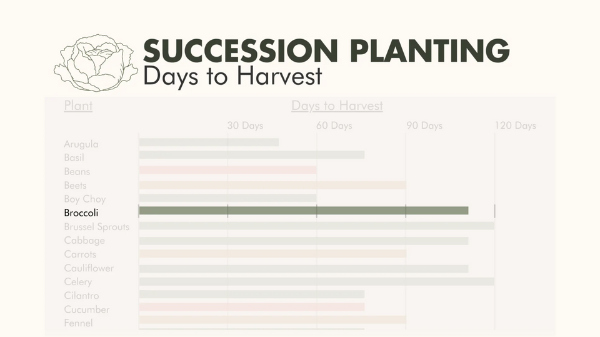It’s that exciting time of year when we’re starting to see our gardens explode with activity and growth! This means we’ll soon be pulling delicious and bountiful harvests from all the plants we started from seed and nurtured to this point. However, after harvesting these crops, I found that I was left with an unsightly and unproductive empty space in the garden. Not great! Then I found out about Succession Planting and I was away to the races!
(To keep this blog post from turning into the Don Quixote of Gardening blog posts I’m going to assume you know about Succession Planting. If not, we’ve got a great resource that goes through everything to do with Succession Planting)
So with that, let’s discuss what plants are good for Succession Planting!
What Crops Are The Best For Succession Planting?
Nearly every crop can be planted as a succession crop, but for planning purposes, we want to categorize them as either Fast Crops or Long Crops

Fast Crops are plants that have a shorter time to maturity while long crops have a longer time to maturity. For example, arugula is a fast crop because its time to harvest is around 45 days while broccoli is a long crop because its time to harvest is approximately 100 days. So how do we approach Succession Planting a fast crop vs. a long crop? Let’s dive in!
Fast Succession Crops
Again, a fast crop is one where its time to harvest is rather quick (relatively speaking). We have a handy little Succession Planting Guide for download at Mind & Soil where we’ll give you the Days to Harvest for multiple plants, both fast and long. Super useful! Anyway, let’s list off the top 10 fast crops for harvest:
The 10 Best Fast Succession Crops
- Arugula: A few great varieties include Astro, Winter Blend, and Esmee.
- Beans: A few great varieties include Gold Rush, Royal Burgundy, and Goliath.
-
Beets: A few great varieties include Avalanche, Detroit Supreme, and Chioggia Guardsmark.
- Turnips: A few great varieties include Purple Top, Silky Sweet, and Hakurei.
- Bok Choy: A few great varieties include Dwarf White, Jade Spring, and Mei Qing Choi.
- Kale: A few great varieties include Winterbor, Lacinato, and Red Russian Kale
- Lettuce: A few great varieties include Red Salad Bowl, Dillon Organic, and Buttercrunch.
- Peas: A few great varieties include Super Sugar Snap, Sabre, and Oregon Giant.
- Radishes: A few great varieties include French Breakfast, Amethyst, and Black Spanish Round.
- Spinach: A few great varieties include Olympia, Seaside, and Yukon.
Steps To Succession Plant Fast Crops
For the Fast Crops, you can direct sow them into the garden every 2-3 weeks following these simple steps:
- Add Worm Casting Seedling Mix: Spread 2 liters of Worm Casting Seedling Mix per square foot. Gently massage it into the top 1" of soil.
- Spacing: Make 1cm divets at the correct spacing intervals for the type of plant that you are starting (i.e. 8 per square foot for Beets, 4 per square foot for Arugula. Google it if you don’t know!)
-
Add Seeds: Place 3 seeds into each divet.
- Add Worm Castings: Cover each divet with 1cm of Worm Castings to help with germination. Water thoroughly to begin the germination process.
- Thinning & Fertilizing: After 14 days, thin the seedlings to one per divet by pinching the main stem of any extra seedlings. Once thinned, apply 2x tablespoons per square foot of an organic fertilizer (such as our 4-4-4 Superfood).

Long Succession Crops
A long crop is one where its time to harvest is rather long (relatively speaking). Once more, we have a handy little Succession Planting Guide for download at Mind & Soil where we’ll give you the Days to Harvest for multiple plants, both fast and long.
The 10 Best Long Succession Crops
- Broccoli: A few great varieties include Aspabroc Broccolini, Calabrese, and Gypsy.
- Cauliflower: A few great varieties include Amazing, Trevi, and Skywalker Organic.
- Potatoes: A few great varieties include French Fingerling, Yukon Gold, and Warba.
- Carrots: A few great varieties include Bolero, Scarlet Nantes, and Ya Ya Organic.
- Parsnips: A few great varieties include White Spear, White Satin Coated, Tender and True Organic.
- Winter Squash: A few great varieties include Table Queen, Reno, and First Taste Kabocha.
- Cabbage: A few great varieties include Kalibos, China Express, and Integro Coated Organic.
- Zucchini: A few great varieties include Black Beauty Organic, Raven, and Goldy Organic.
- Kale: See the examples in the section above for our favorite Kale crops!
- Onions: A few great varieties include Borettana, Rossa di Milano, and Patterson seeds.
Now let’s get into the process of how to succession plant long crops!
Long crops take a bit more effort because we will be starting them from seed and then transplanting them into the garden after approximately 14-21 days. But let’s attack how to do this in two phases: what supplies you will need and then the different steps you need to go through to be successful with long crops.
What Supplies You Need For Long Crops:
- Seed Cells: We will start our Long Crops in seed cells so that they can begin germinating and growing while other vegetables finish their growing cycle in the garden. Once harvested, we'll transplant the Long Crop from its seed cell into the garden.
- Worm Casting Seedling Mix: Long Crops need to be started in seed Cells, so we want to have some Worm Casting Seedling Mix readily available to start them in.
- Hori Hori Knife: Long crops will be transplanted into the garden after 14-21 days inside, and having a Hori Hori Knife on hand makes the transplanting process a breeze.
Steps To Succession Plant Long Crops
Now, let’s get into the steps to succession plant long crops! For the Long Crops you will need to be a little bit more measured with your timing to ensure they have enough growing days before winter:
-
First Frost: Google the name of your city and the words first frost (i.e. Vancouver First Frost, Burnaby First Frost) to determine the end of your growing season. Jot this date down! (It’s important!)

-
Days to Harvest: Using the Days to Harvest Infographic (available for download at the top of the linked page!), determine the number of days your crop will need to grow (i.e. Broccoli = 100 days to harvest).

-
Days Remaining: Google the number of days to harvest and the first frost date (i.e. for broccoli Google: 100 days until October 10th - see below) to determine what day you need to start your seeds on in order to have a long enough growing window for the plant to reach harvest. (i.e. Saturday, July 2nd for Broccoli, meaning we need to start our broccoli on Saturday, July 2nd if we want to be able to harvest before the first frost date)

- Fill Seed Cell with Worm Casting Seedling Mix: Use 3" Seed Cells and fill them to the top with worm casting seedling mix. Tap the bottom of the seed cell on the ground to gently compact the seedling mix, creating about 1cm of space from the top of the seedling mix and the top of the seed cell.
-
Add seeds & water: Place 5 seeds on the top of the seedling mix in each seed cell (i.e. 5 beet seeds per seed cell). Once the seeds are placed, add a generous amount of water (we like to use turkey basters for watering and give each seed cell = 2x turkey basters of water) to create a moist environment for the seeds to germinate.

- Cover with Worm Casting Seedling Mix: Cover the seeds with about 1cm of worm castings seedling mix so that it is in line with the top of the seed cell. Add a third turkey baste of water to begin the germination process.
- Water Every 2-3 days: Place the back of your hand on the top of the seedling mix every 1-2 days. If you don't feel any moisture, add the next 1x turkey baste of water to ensure the seeds are always in a moist and warm (+70F/21C) environment for germination.
-
Transplant: 14-21 days after starting the seeds, transplant the seedlings into your garden. Dig your transplant holes accordingly and add 1 handful of worm castings and 1 tablespoon of 2-6-4 Rooted Food to the transplant hole. Transplant the seedling into the transplant hole. Backfill with the surrounding soil. Add an additional 1-2 handfuls of worm castings and 1-2 tablespoons of 2-8-4 Rooted Food per square foot as a top dressing to the garden space you just planted into.

So there you have it – everything you need to know about extending your growing season, which seeds are the best to use, and how to succession plant both fast crops and long crops! Just remember to plan ahead, order your supplies early, and get ready for an abundance of fresh produce this year!
Go get your hands dirty!



